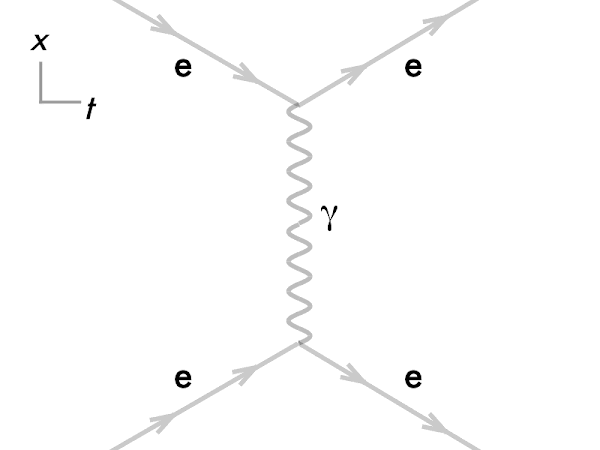Cuesta College, San Luis Obispo, CA
Students have a weekly online reading assignment (hosted by SurveyMonkey.com), where they answer questions based on reading their textbook, material covered in previous lectures, opinion questions, and/or asking (anonymous) questions or making (anonymous) comments. Full credit is given for completing the online reading assignment before next week's lecture, regardless if whether their answers are correct/incorrect. Selected results/questions/comments are addressed by the instructor at the start of the following lecture.
The following questions were asked on reading presentations Feynman diagrams (Phillip "Flip" Tanedo, Cornell University/USLHC Collaboration) and quantum electrodynamics (QED) (Christopher "Bot" Skilbeck, cronodon.com).

Ralph Leighton
symmetrymagazine.org/article/may-2014/saving-the-feynman-van
Selected/edited responses are given below.
Describe what you understand from the assigned textbook reading or presentation preview. Your description (2-3 sentences) should specifically demonstrate your level of understanding.
"In a Feynman diagram matter particles and force particles interact with each other."
"Quantum electrodynamics can be explained simply with the feynmans diagrams. Electrons that are going toward eachother will emit a photon which causes the repel of one another. The positron and electron can annihilate into photons which is detectable."
"Feynman diagrams contain one line going in, one coming out, and one squiggly (or else invalid). Positrons annihilate electrons."
"How to draw a Feynman and for the most part what I means with the particles and the photons. I am starting to understand how to read the diagrams for example what kind of interaction is happening."
"A system can borrow some energy for a long time or a lot of energy for a short time. This meaning that if a system creates a highly energetic virtual particle, then that particle is shorter-lived."
"About as much as I did after the last lesson. I'm starting to get what we covered last lecture in class but I'm still really fuzzy on a lot."
"I understand nothing."
Describe what you found confusing from the assigned textbook reading or presentation preview. Your description (2-3 sentences) should specifically identify the concept(s) that you do not understand.
"A lot of this material from the reading was really hard for me to understand. I struggled the most with figuring out the charges on photons, pions, etc."
"I'm having a hard time understanding the section in general. I kind of get how to read the Feynman Diagrams, but other than that I don't get the conceptual meaning behind it all."
"ALL OF THE THINGS."
"Pretty much everything."

negative. **** [4] zero. ************** [14] positive. *** [3] (Unsure/guessing/lost/help!) ***** [5]

negative. **** [4] zero. ** [2] positive. ************ [12] (Unsure/guessing/lost/help!) ******** [8]

negative. *** [3] zero. **** [4] positive. ********* [9] (Unsure/guessing/lost/help!) ********** [10]
The (valid) Feynman diagram in the previous question above depicts a(n) __________ decay process.
α. * [1] β+. ***** [6] β–. * [1] electron capture. ****** [6] γ. ** [2] (Unsure/guessing/lost/help!) ********** [10]
Ask the instructor an anonymous question, or make a comment. Selected questions/comments may be discussed in class.
"I'd like to know what is these symbols in the diagram and be able to read them."
"Can you go over the diagrams again and how to read what the letters mean? I'm having trouble understanding."
"I think I will be fine after having a lecture on this material. I am just wondering how much of this we are going to need to know since we have one week left of class."
"For future classes, would there be any way to break up the QED readings into a more digestible form? Or break up the readings into smaller chunks? I think that might help to keep people from being overwhelmed by the amount of confusing information in the readings. I know that makes a lot more work for you, but I think it could help. Even if you didn't do anything with it, I think it could be helpful if you warned people to take it in small chunks over multiple days (I'm a chronic procrastinator, so I definitely didn't do that, but a heads up might help future classes) :) Keep up the hard work! The semester is almost over :)"
No comments:
Post a Comment